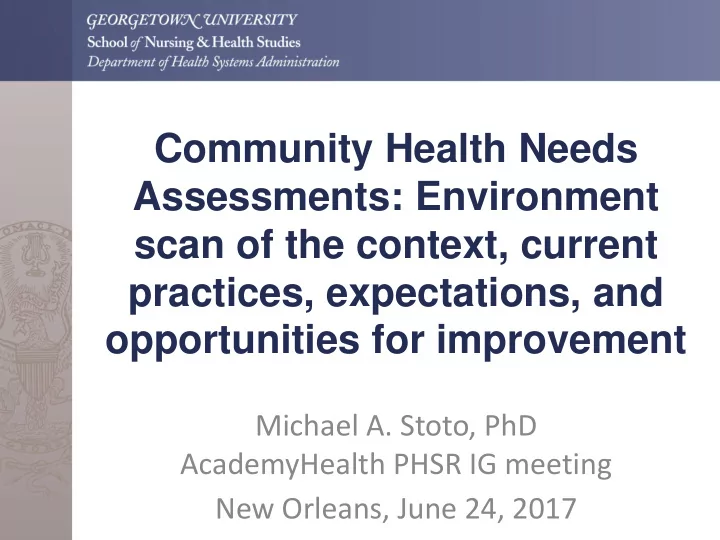

Community Health Needs Assessments: Environment scan of the context, current practices, expectations, and opportunities for improvement Michael A. Stoto, PhD AcademyHealth PHSR IG meeting New Orleans, June 24, 2017
Acknowledgements • Co-authors on environmental scan – Mary Davis and Tamar Klaiman • National advisory and liaison panels • Phase II – Abby Atkins & Kristin Mikolowsky, Health Resources in Action (HRiA) • Robert Wood Johnson Foundation – Nancy Fishman
Background • ACA-mandated IRS regulations require non-profit hospitals to work with health departments and other community organizations to – conduct a Community Health Needs Assessment (CHNA) every three years – adopt an Implementation Strategy describing how identified priorities will be addressed • Potential to bridge efforts of healthcare delivery sector, public health agencies, other organizations to improve population health outcomes • Research questions – why have regulations have not yet realized this potential? – identify approaches that can help them do so
Methods • Environmental scan of the forces of change in – healthcare delivery system – public health system – other factors that affect the context in which CHNAs are conducted • Literature included – peer-reviewed and gray literature on changes in the healthcare delivery and public health systems – specifically studies of the implementation of CHNAs and similar processes • This presentation is a high-level summary – examples rather than comprehensive lists
Changes in the U.S. healthcare delivery system • Transformation from volume to value – Triple Aim: improving experience of care, improving the health of populations, reducing costs of healthcare • Manifestations – Accountable Care Organizations, Accountable Health Communities, Patient-Centered Medical Homes, etc. – CMS goals to increase value-based payment – CMS State Innovation Model (SIM) initiative • Implications – Accountability for outcomes – Partnerships needed to address social determinants
Multi-sector collaboration (public health, healthcare delivery organizations, etc.) • IOM: Primary care – public health collaboration • Health department accreditation • DeSalvo et al. : Public Health 3.0 • RWJF Culture of Health • Health in All Policies approach • Federal Reserve Bank of San Francisco: Pathways to System Change • Kania & Kramer Collective Impact framework – Common agenda; Shared measurement systems; – Mutually reinforcing activities; Continuous communication; Backbone support organization
CHNA & IS guidance & resources • IRS final regulations • State requirements – Community benefit, hospital & county community health assessments and implementation strategies, etc. • Model approaches – CHA, ACHI, etc. – NACCHO MAPP • Resources – State models and data systems – County Health Rankings & Roadmaps – CHNA.org Toolkit – NQF’s Guide for Community Action – CDC’s Community Health Improvement Navigator – All In: Data for Community Health – de Beumont Foundation’s Practical Playbook
“Recent” CHNAs & implementation strategies (mostly first round of hospital CHNAs, so out of date) • Compliance with the primary IRS requirement – to conduct a CHNA and make it publicly available – is high, but not universal • Although required, excess variation in the degree to and manner in which hospitals solicit and take into account input from – local health departments and other individuals with public health knowledge and expertise – leaders, representatives, or members of medically underserved, low-income, and minority populations in the community
“Recent” CHNAs & implementation strategies (mostly first round of hospital CHNAs, so out of date) • Excess variation in – how hospitals define the community they serve – collaboration with local health department – methods hospitals use to choose priorities • remarkably consistent in priorities identified – clinical care: ~ 2/3 – health behaviors: 1/4 – 1/3 – social and economic factors: few – physical environment: almost none • More focus on conducting CHNAs than on – implementing strategies – monitoring efforts and evaluating the results
Open questions • IRS and state requirements and expectations about community benefits and CHNAs/IS • Definition of a hospital’s community served – relationship to geopolitical boundaries • Models for priority setting • Collaboration among hospitals and with public health and other organizations for – needs assessments & priority setting – implementation strategies • Evaluation and performance measurement – overall health improvement – of implementation strategies
Next steps • Shift focus to “community health improvement” (CHI) processes • “ Evaluability assessment” – Identified list of ~100 CHI processes • hospital- and community-based • involving ~500 hospitals – winnow down to 10-15 for in-depth case studies • ready to be evaluated • evidence of success • variation in context, geography, public health system comprehensiveness, CHI process type, …
Draft criteria for a “successful” Community Health Improvement process A single, grounded, and collective process that integrates hospital, health department, and community priorities (partnerships), including identifying the root causes of health problems within a community, including social determinants Full, broad community engagement Clear definition of intended outcomes (including reduction of inequalities and inequities) Out of the assessment come clear, focused, measurable objectives and outcomes, including outcomes that address health inequities Outcomes are realistic and addressed with specific action plans to designed to eventually improve population health, including reducing inequities Plans become fully integrated into agencies and become a way of being for the agencies
Recommend
More recommend